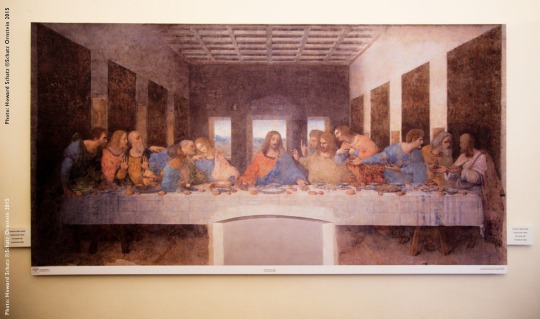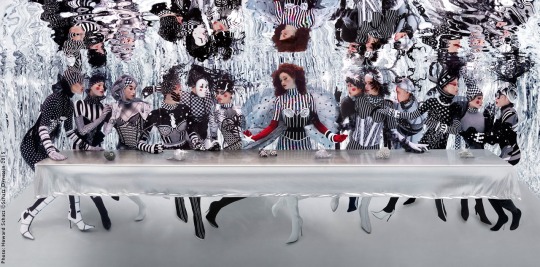
BLOG #113
11/24/2015
I have been awed and inspired by Leonardo da Vinci’s Last Supper since I first saw at the monastery of Santa Maria delle Grazie in Milan, Italy, long ago. This is the photograph I made when I first saw it:
I had been working intensely on underwater images, and had solved the many problems that a subaquatic “studio” presents, and so I decided to do my own Last Supper––with humble thanks to Leonardo—underwater. Although the image appears complex, it was actually not hard to photograph: preparing to make the picture was daunting: this blog is a lesson in preparation.
Though the biblical Last Supper was an all male gathering, I decided to bend the genders and include all women. I had already worked with many models and dancers underwater, so I knew that casting wouldn’t be a major challenge. And the placement of the characters had been done for me already by the great Renaissance genius. But what I needed to create was the “look.” What would the models wear? What was the make-up? What was the environment?
Since the story behind Christ’s last seder is one of betrayal and ultimately death, I decided to make the image black and white , and use red as the only color on the central figure.
Months ahead of the planned shoot, I went to New York’s fabric district in the West 30’s and searched for graphically designed black-and-white four-way stretch Spandex. I found 12 different patterns and bought 4 yards of each. As well, I found an additional one with red, for “Jesus.”
Two yards of each were sewn into a unitard, tights that went from neck to wrist to ankle. The creative milliner, Kokin, used some of the additional two yards of each pattern to make amazing hats and the brilliant stylist, Nikko Kefalas, used the rest to make gloves, bustiers, and other accessories.
When making fashion or beauty images underwater, it was crucial to decide on the make-up beforehand. If the make-up is wrong and doesn’t “fit” the shoot, the model has to get out of the water, remove her clothes, dry off, get into a robe and have the make-up removed. The make-up artist then needs to start over. In a time-pressure shoot, with other models involved, such a glitch can create a disastrous delay.
And so, in preparation, I asked Alberto Luengo, a wonderfully talented make-up artist with whom I’ve worked on many other projects, to make drawings for each of the 13 characters. I wanted the make-up to have a certain “feel” and asked him to explore various possibilities. Slowly but surely, and with many “close ones” as well as rejects, Alberto drew and we came to an agreement for each of the 13. I knew exactly what the model would look like when she came to the pool.
For the background, I used a “rain curtain” of highly reflective Mylar to heighten the effect of the models’ reflections on the under surface of the water. The table was a long rectangular piece of clear plexiglas, which I knew would not float. I held the table in place with clear monofilament (much like fishing line) at each corner. I covered the table with a semi-reflective material and used drapery weights to keep the material flat on it.
Before the models entered the pool I rehearsed the pose I desired with each one.

I decided on lighting each model equally and therefore placed a 20’ x 20,’ one-stop scrim over the pool. I placed strobes a safe distance from the pool (the general rule, for safety, is that the stand holding the light must be twice its length distant from the edge of the pool – a seven foot high stand is placed 14’ away, for instance, so if it falls it will not come anywhere near the water.) Six powerful strobe heads from six individual 3200 mw packs were used to transmit the light through the scrim and create an even soft illumination.
With the lights, backdrop, and my camera in its underwater housing all prepared, the models, made up according to the approved drawings, entered the pool. They took their designated places around the table. I explained to them that there was no need for me to make many exposures. The set was in five feet of water so all they needed to do was blow out some air and bend their knees to be submerged. Since we had practiced the poses for each model and they were all veterans of other underwater shoots with me, they knew how to maintain a normal face, what to do with their hands, how to turn their heads.
I made only a few exposures and knew that the image was made. I asked them to make a few more dips to be sure, changed the exposure some; the shot – after months of preparation – was over in a matter of minutes.
Thanks to Leonardo Da Vinci, this is one of my images that has gotten a great deal of attention, has won “best photograph” awards and has sold as vintage limited edition (8 vintage prints, 5 sold) fine art prints in some of the galleries that show our work.
